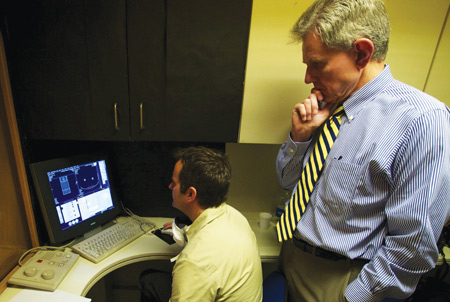Horus: Scanning ancient populations for evidence of atherosclerosis
Researchers are looking to the past for clues to modern cardiac diseases.
A study of geographically and culturally diverse populations spanning more than 4,000 years suggests atherosclerosis was prevalent in ancient civilizations and may in fact be a natural part of the aging process.
“In the last century, atherosclerotic vascular disease has replaced infectious disease as the leading cause of death across the developed world. A common assumption is that the rise in levels of atherosclerosis is predominantly lifestyle-related and that if modern humans could emulate pre-industrial or even pre-agricultural lifestyles, that atherosclerosis, or at least its clinical manifestations, would be avoided,” Randall C. Thompson, MD, of St. Luke’s Mid America Heart Institute in Kansas City, Mo., said in a press release.

Randall C. Thompson
Now, new data from the Horus study “seem to cast doubt on the assumption and, at the very least, we think [the data] suggest that our understanding of the causes of atherosclerosis is incomplete, and that is might be somehow inherent to the process of human aging,” said Thompson, who presented the findings at the American College of Cardiology Scientific Sessions in March.
The Horus researchers performed whole-body CT scans on 137 mummies from ancient Egypt (n=76), Peru (n=51), Ancestral Puebloans of southwest America (n=5) and Unangan hunter-gatherers from the Aleutian Islands in Alaska (n=5). They defined atherosclerosis as definite if calcified plaque was observed in the artery wall and as probable if calcifications were observed along the expected course of an artery.

An Egyptian mummy prepped to undergo scanning.
Photos courtesy of: L. Samuel Wann, MD; printed with permission.

L. Samuel Wann, MD, and a colleague examine evidence of atherosclerosis found by imaging a mummy in Egypt.
Probable or definite atherosclerosis was identified in 34% of the mummies, including 38% of the Egyptians, 25% of the ancient Peruvians, 40% of the Ancestral Puebloans and 60% of the Unangan hunter-gatherers.
Overall, 20% of the mummies examined had evidence of atherosclerosis in the aorta, 18% in the iliac or femoral arteries, 18% in the popliteal or tibial arteries, 12% in the carotid arteries and 4% in the coronary arteries. Data also indicated the presence of atherosclerosis in one to two of five vascular beds examined in 25% of the mummies, three to four beds in 8% and all five beds in 1%, according to the study results, which were simultaneously published in The Lancet.
Mean age at death was 43 years for mummies with evidence of atherosclerosis vs. 32 years for those with no evidence (P<.0001), suggesting a positive correlation between age and development of the disease. Similarly, mean age of those with presence of atherosclerosis in one to two arterial beds was 42 years vs. 44 years for those with atherosclerosis affecting three to five beds (P<.0001), the researchers reported.
In an interview with Cardiology Today, L. Samuel Wann, MD, researcher with the Horus study and cardiologist at Columbia-St. Mary’s Healthcare, Milwaukee, said the evidence of atherosclerotic plaque in the mummies studied was more prevalent than the researchers thought they would find.
“One surprise was the presence of atherosclerosis even in hunter-gatherers in the Aleutian Islands,” Wann said.
Other responsible risk factors
For 4,000 years we have had evidence of cardiac disease, Wann said.
“It is surprising that atherosclerosis is so very easy to find in these ancient cultures across the globe over a very wide time span and among people with very different genetics, lifestyles and diets,” Thompson said. “One implication is that this disease that we think of in terms of modern lifestyles and diet is actually related to aging. Or perhaps we don’t understand the risk factors as well as we think we do.”
In an accompanying editorial, Anthony M. Heagerty, MBBS, MD, FRCP, FAHA, FMedSci, of the University of Manchester, U.K., postulated that infection may be responsible for the development of atherosclerosis in these ancient populations.
“A wealth of evidence points to a key role for inflammation in both circulatory and malignant processes,” he wrote. “High levels of chronic infection and inflammation could have promoted cardiovascular lesion development and, although not being fatal for most, might have become so with the passage of time.”
Further research by this team and others is under way to identify possible causes of atherosclerosis in these diverse ancient populations.
“This does not mean traditional risk factors — smoking, a high-fat diet, obesity, diabetes and the like — are not important, but it does mean that atherosclerosis has been around for thousands of years. We have a lot to learn about how to interpret these data and how to prevent future cardiac events,” said Wann, who is the Cardiology Today Section Editor for Practice Management and Quality Care.
The lesson, however, is that prevention remains key.
“These data confirm that atheroma has been a burden on the human circulation for centuries. Few are exempt, and as life expectancy lengthens owing to modern advances in public health and medicine, more will suffer its consequences unless urgent measures are taken to prevent its legacy,” Heagerty wrote in The Lancet.
Disclosure: The researchers report no relevant financial disclosures. Heagerty has consulted for and received fees for speaking from Daiichi Sankyo, Merck, Novartis, Serono and Servier. Wann reports no relevant financial disclosures.
